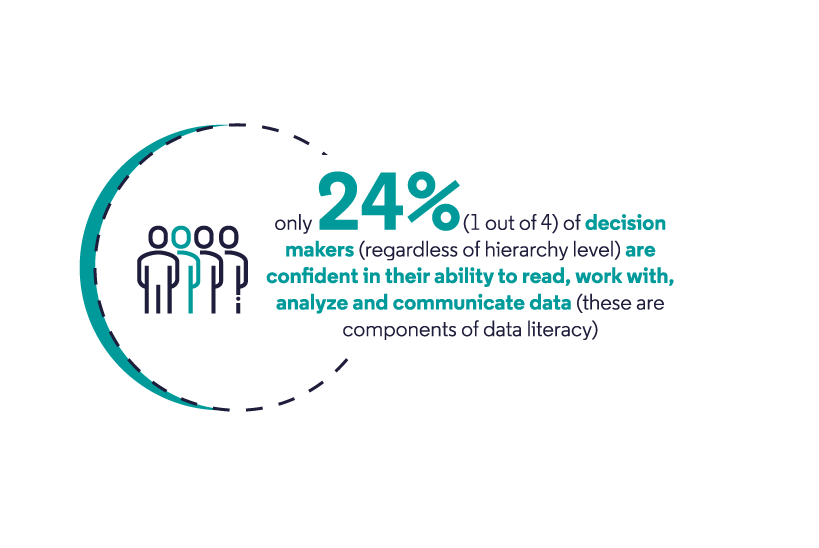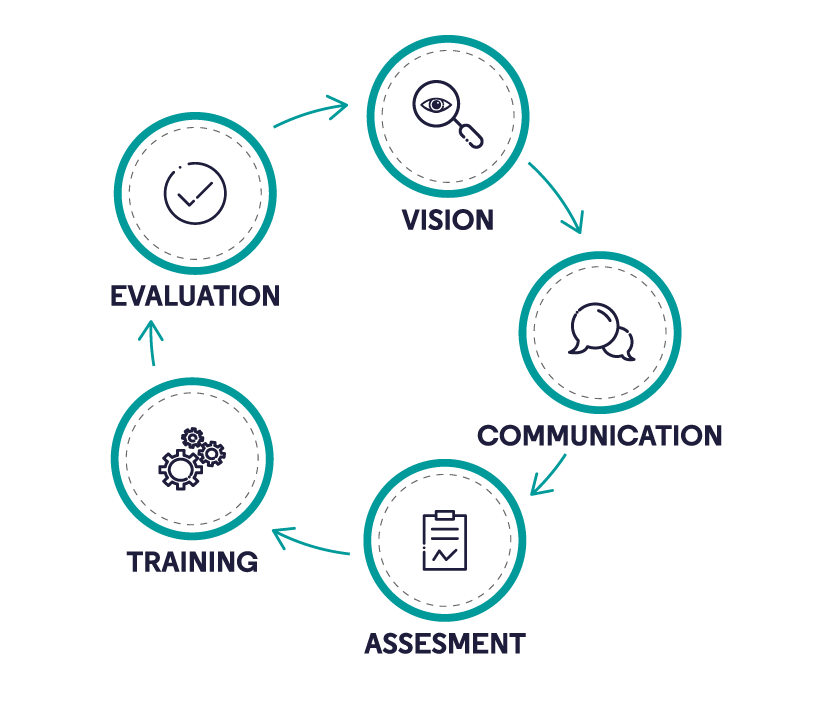What organization culture supports a data-driven organization, and how to build it.
31 August 2021
Key points:
- How to know that your organization is data mature?
- Does your org structure support a data-driven approach?
- What data literacy is?
- How to uplift data literacy within your organization?
Although I work in a very tech company, at the beginning I must disappoint you – enormous investments in technology do not ensure that you will become a data-driven organization. According to the latest NewVantage Partners “Big Data & AI Executive Survey 2021”, only 24% of asked organizations declared that they have created data-driven organizations. 92% of responders pointed out as main blockers, on the road to unlocking the full data potential, not technology but people and business processes.

In this post, I am not going to talk about technology. You do not need advanced technology to use the power of data in your organization. Basic Excel is good enough. Of course, using Excel is not as sufficient, productive, and easy to collaborate as using Power BI and a well-organized central data model. Still, advanced technology is not a must-have of data-driven organizations. So, what is?
Data Culture
The simple answer is Data Culture. As we all know this buzzy world, do we really understand what does it mean? Each organization has its unique culture: shared values, assumptions, attitudes, habits, and beliefs that instinctively drive and influence people’s behavior. Data Culture is something similar, but it concentrates on the attitude towards data awareness and data usage. In data-driven organizations, data culture is an integrated part of the organizational culture.
Evidence on having established Data Culture.
If you are not sure if the data culture is successfully introduced into your organization, check out if in your organization you can find some of below positive employees’ behaviors examples:
- Managers, before making any strategic decisions investigate data and ask for additional analysis or possible scenarios.
- Each department has its metrics to measure performance and those metrics are transparent and available for everyone.
- Employees, when preparing to client’s conversations checking out possible data, e.g. recent sales or most purchased products.
- People discuss facts and form opinions based on facts rather than gut feelings.
- C-levels managers mitigate risks based on long-term and short-term trends.
- Campaigns are differentiated according to Clients’ segments that are based on specific measures.
- The marketing department can tell which campaign had a higher impact based on their results.
- Business processes are constantly measured and optimized.
- You know the habits of your customers because you collect data about them.
- You can prevent frauds because you know how to detect them by analyzing data.
Nothing from above would happen if your employees do not have sufficient data literacy. Data-driven decision-making starts in the mind of people. Only people hungry for fact-based information are eager to dive into the ocean of data to find some significant, shining pearls of insights. However, in the real world, it is not so simple. According to the latest Qlik Data Proficiency Report, only 24% of decision-makers (regardless of hierarchy level) are confident in their ability to read, work with, analyze and communicate data (these are components of data literacy).
That means, even if they see potential in data usage, they lack the skills to unlock it. So, how to deal with that?
Organizational structure
Before we discuss how to make people more data literate, let’s start with a structure that supports establishing Data Culture.
Maybe you are asking yourself why to bother? Well, from my experience nothing will happen in the company without engagement leadership. Someone must be in charge. When it comes to making the company more data-driven, there is no better choice than Chief Data Officer (CDO). This person is properly educated and has needed the know-how to help organizations grow in the data field. On the other hand, she or he has an adequate high position in the company to make strategic decisions and create long-term programs. If there is no such role in your organization, think about someone, who is from the top management and already is passionate and understood data.
Nevertheless, under CDO, there is a whole department that covers tasks like Data Governance and Analytics. Those people should work with businesses as close as possible to teach others in the company how to benefit from data. The true win-win here would be the synergy effect. Data people can act as advocates of data literacy. They will teach employees how to read, work with, analyze and communicate data, but businesspeople will teach them understanding business. This synergy is a significant game-changer that accelerates company growth.
Data literacy programs
If you think seriously to drive your company by data, you must support your employees in developing and improving skills to read, work with, analyze and communicate data. Any program needs to have stages, steps, or phases, and it is impossible to do it at once. It is a huge effort to bring these changes to life.
Five stages of the effective data literacy program:
- Vision – It covers internal discussion about the timeframe, scope, and budget. The important question is about participants. Especially, when your organization is large, you must decide who and why will participate in first place in the program.
- Communication – be as much transparent as possible with your employees. Explain why the program is introduced, and who can attend.
- Assessment – conduct a data literacy survey among all employees to find out their potential. Having that knowledge, you will better tailor training for them.
- Training – you can do it internally, but you can use well-crafted courses like our “Power BI Course”. This course covers much more than the ability to use Power BI. The course bases on a good set of data and during the lessons together with my colleagues we teach you:
- How to work with data,
- How to look for patterns within the data set,
- And eventually, how to communicate data visually to others.
- Evaluation – the last stage is to check out program outcomes. What worked fine, and what needs to be improved. If the program is effective or should be tweaked to better results.

Finally, it is hard to laugh at Moliere’s comedy if you cannot read. The same benefits are from having the best BI solutions in place without supporting people in upgrading their analytical and technical skills. So do not throw the baby out with the bathwater, and parallel with digitization race in your workplace, make sure that your employees are prepared for that long-distance effort too.
